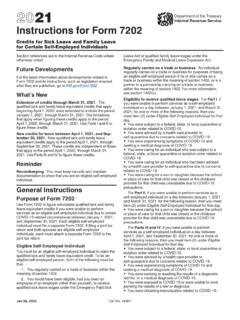Transcription of FACTORS AFFECTING INDIVIDUALS TO ADOPT MOBILE …
1 Yu: FACTORS AFFECTING INDIVIDUALS to ADOPT MOBILE Banking Page 104 FACTORS AFFECTING INDIVIDUALS TO ADOPT MOBILE BANKING: EMPIRICAL EVIDENCE FROM THE UTAUT MODEL Chian-Son Yu Department of Information Technology and Management Shih Chien University # 70, DaZhi Street, Taipei, Taiwan ABSTRACT Fast advances in the wireless technology and the intensive penetration of cell phones have motivated banks to spend large budget on building MOBILE banking systems, but the adoption rate of MOBILE banking is still underused than expected. Therefore, research to enrich current knowledge about what affects INDIVIDUALS to use MOBILE banking is required.
2 Consequently, this study employs the Unified Theory of Acceptance and Use of Technology (UTAUT) to investigate what impacts people to ADOPT MOBILE banking. Through sampling 441 respondents, this study empirically concluded that individual intention to ADOPT MOBILE banking was significantly influenced by social influence, perceived financial cost, performance expectancy, and perceived credibility, in their order of influencing strength. The behavior was considerably affected by individual intention and facilitating conditions. As for moderating effects of gender and age, this study discovered that gender significantly moderated the effects of performance expectancy and perceived financial cost on behavioral intention, and the age considerably moderated the effects of facilitating conditions and perceived self-efficacy on actual adoption behavior.
3 Keywords: MOBILE banking, UTAUT, wireless commerce, technology adoption 1. Introduction With the recently quick growth in the market of 3G smart MOBILE phones, the wireless service delivery channel becomes a promising alternative for firms to create commercial opportunities. However, despite many wireless commercial services increase quickly, the use of MOBILE banking service is much lower than expected [Cruz et al. 2010] and still underused [Huili & Chunfang 2011], and the market of MOBILE banking still remains very small in comparing to the whole banking transactions [Luarn & Lin 2005; Laukkanen 2007; Yang 2009].
4 That is, the widespread adoption and large usage of cell phones did not reflect on the adoption and usage of MOBILE banking, although MOBILE banking perhaps was the first commercial MOBILE service [Scornavacca & Hoehle 2007] and first introduced in the early 2000s through short messaging service and wireless access protocol [Dasgupta et al. 2010]. Both Internet banking and MOBILE banking are often considered as electronic banking [Suoranta & Mattila 2004; Laforet & Li 2005; Laukkanen 2007; Sripalawat et al. 2011], but Internet banking and MOBILE banking are two alternative channels for banks to deliver their services and for customers to acquire services [Scornavacca & Hoehle 2007].
5 That is, customers using Internet banking are through computers connected to Internet, while customers using MOBILE banking are through wireless devices [Riquelme & Rios 2010]. Concerning the difference between online banking and MOBILE banking contexts, customers considered mobility as the most valued feature of MOBILE banking [Suoranta & Mattila 2004] and the time-critical consumers considered the always-on functionality as the most important feature of MOBILE banking [Singh et al. 2010], while banking users considered that Internet banking took significant advantage in Usefulness and Purpose [Natarajan et al.]
6 2010] and online banking was suggested as the cheapest delivery channel [Koenig-Lewis et al. 2010]. Considering the immense penetration of cell phones, Cruz et al. [2010] observed that banks has very large potential to offer MOBILE banking services to people living in remote villages where only few computers are connected to the Internet. Acknowledging the limitations of Internet banking as opposed to widespread MOBILE phone penetration, Dasgupta et al. [2011] suggested that the emerging MOBILE banking may give banks a good commercial opportunity providing their services to rural people who are unable to access the Internet.
7 Hence, Dasgupta et al. [2011] pointed out that main customer segments of MOBILE and Internet banking were not necessarily the same, which might explain why Sadi et al. [2010] distinguished MOBILE commerce from other electronic commerce. Journal of Electronic Commerce Research, VOL 13, NO 2, 2012 Page 105 Therefore, compared to huge online banking studies and relative few research available to help banks understand the adoption of MOBILE banking [Suoranta & Mattila 2003; Laukkanen & Pasanen 2008; Puschel et al. 2010], more studies to investigate what influences people to ADOPT MOBILE banking are necessary and demanded.
8 Given that the chance of success in introducing a new product or service is highly related to the depth of understanding of what influences consumers to ADOPT this new product or service, this study employed the unified theory of acceptance and use of technology (UTAUT) with age and gender as moderating effects to elaborately investigate what AFFECTING INDIVIDUALS to ADOPT MOBILE banking. The findings culled from this research can help banks execute intricate marketing campaigns and customize service options to cater to specific customer segments in the context of electronic banking.
9 2. Literature Review Literature reveals that abundant research on electronic banking has focused on Internet banking (also called online banking), whereas research focusing on MOBILE banking is relative little and receives underrated attention [Suorantia & Mattila 2004; Laukkanen & Pasanen 2008; Puschel et al. 2010]. By employing innovation diffusion theory (IDT) and the decomposed theory of planned behavior (DTPB), Brown et al. [2003] surveyed 162 respondents and discovered that perceived advantages, the opportunity to try out cell phone banking, the number of banking services required by respondents and perceived risk significantly influenced people to ADOPT MOBILE banking.
10 Lee et al. [2003] performed eight interviews to collect transcripts from participants and concluded that relative advantages and compatibility were positive FACTORS AFFECTING the adoption of MOBILE banking, perceived risk was negative factor AFFECTING the adoption of MOBILE banking, and consumer previous experience and self-efficacy generalized their beliefs (a negative or positive attitude) toward the adoption of MOBILE banking. Suoranta and Mattila [2004] took the Bass model of diffusion to separate 1253 respondents into non-users, occasional users, and regular users according to their MOBILE banking usage experience and density.




